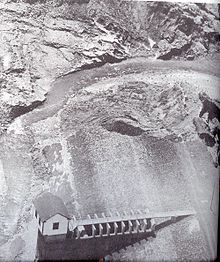Johnstown flood of 1977
Nearly 12 inches (300 millimetres) of rain fell in 24 hours when a thunderstorm stalled over the region, and six dams in the area over-topped and failed.
He laid out plans for a town and chose the name Conemaugh after a Native American village that occupied the same site.
After this, the U.S. Army Corps of Engineers undertook a study with the aim of redesigning Johnstown's infrastructure to permanently remove any future threat of serious flooding.
[6] Colonel Gilbert Van B. Wilkes, Chief of the Army Corps of Engineers, Pittsburgh District, told a Johnstown audience the flood problems had been effectively solved.
An unnamed impoundment dam, holding 1,000 US gallons (3.8 m3) of reserve water for Bethlehem Mines Corporation, also failed.
The victims of the 1977 flooding were from Old Conemaugh Borough (2), Hornerstown (4), Walnut Grove (3), West End (1), Dale Borough (10), Seward (7), Strongstown (1), Tanneryville (39, including those still missing), Windber (2), Summerhill (1), Dilltown (1), Dunlo (3), Mineral Point (2), Richland (6), and Scalp Level (2).
In a city that relied so heavily on the steel industry in its economy, the effects of the disaster were felt for many years afterward.
As the company continued to face a decline in profits in the years following the flood, they looked to Johnstown for solutions.
